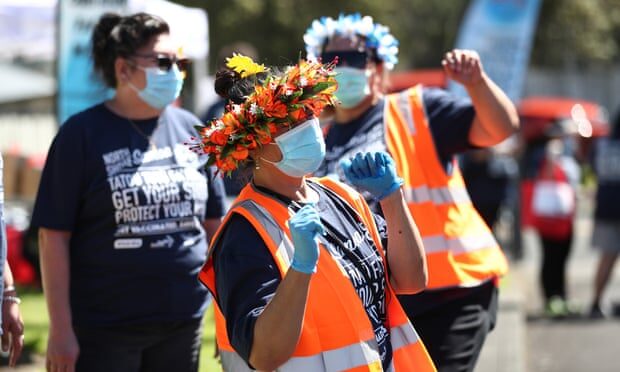Auckland is closing in on 90% of its population having had one shot; 89% of the region's population has now had at least one dose, and 70% are fully vaccinated.
Across the country, 82% of the eligible population (those aged 12 and over) have had at least one vaccination, or 70% of the total population; 64% of the eligible population, or 55% of the full population are fully inoculated with both shots.
Ardern has not yet announced a specific point in vaccination levels where restrictions will be loosened, but has previously ruled out dropping public health measures before the country reaches 90%. She said on Monday afternoon that restrictions would be needed for a while longer to avoid a spike in cases.
Comment: Even at 100% they would find a reason for restrictions.
"If we get this right, if we keep case numbers low while we vaccinate people then it makes it easier for us to keep control of Covid, while we ease restrictions in the future, and that is everyone's goal," she said. "The question for cabinet today has been how do we avoid a spike in case numbers, and hospitalisations, and protect vulnerable communities as much as possible in the coming weeks, while we keep lifting vaccination numbers."
New Zealand announced 60 new cases of Covid-19 on Monday, with the total number of cases in the outbreak hitting 2,005.
Twenty-four of Monday's 60 cases have not yet been linked to existing infections, and 140 cases are unlinked from the past 14 days, suggesting there could be wider spread in the community.
Ardern said that the government would roll out a new "traffic light" framework for pandemic management, which will include a pathway out of lockdown, on Friday. It will include a high vaccination target. She also ruled out a short term level 4 "circuit breaker" lockdown to interrupt spread - saying that noncompliance meant it was less likely to be effective.
Pandemic modeller for research centre Te Punaha Matatini Shaun Hendy told Stuff on Monday that "relaxation at the moment would be very dangerous". While first doses hitting 90% was an important milestone, he said attention should be on the double-dosed figure. Hendy has been calling for government to consider a "circuit breaker" temporary return to level 4 to interrupt virus transmission as vaccination rates rise.
He said on Monday that while that would not take New Zealand back to Covid zero, it could ensure cases did not outpace contact tracing and hospital capacity. "The goal of a circuit breaker would be to contain spread so we can relax with case numbers that are manageable by targeted public health measures. It is not another attempt at elimination, but to keep spread in check while vaccination coverage climbs," Hendy said.
Prominent Māori groups have strongly opposed the prospect of loosened restrictions, and said it would lead to more deaths and illness in indigenous communities. The National Iwi Chairs Forum released a statement on Monday strongly rejecting a new "traffic light" system that the government has been considering to replace its existing alert levels.
"Māori and Pacific vaccination rates have to increase to the same level as other New Zealanders otherwise the infection and mortality rate will disproportionally affect our vulnerable communities," said Lisa Tumahai, chair of the Pandemic Response Group. "Our focus is now giving priority to keeping our communities safe"
Mike Smith, a Māori leader from Ngā Puhi and Ngāti Kuri, said "a strong joint statement was presented to the Crown last night to make it absolutely clear that we reject the Traffic Light Framework".
"The vaccination strategy failed Māori and Pacific communities," Smith said. "It didn't recognise the different demographics in our respective communities, Pakeha have a high number amongst its elderly, for us the highest proportion of our population is our youth so when the Governments Tier approach targeted the elderly, it did not reach into our communities."
Public health professor and epidemiologist Michael Baker said vaccination was not yet high enough to limit an outbreak size if restrictions were loosened up. "We've got only a small benefit coming from rising vaccine coverage, also the move into summer - I don't think that will be enough to balance the effects of much more exponential rise," he said. "With a [case number] doubling time of two weeks, where will that put us in that pre-Christmas period? Will we be in danger of overwhelming the health system?"
Baker said the introduction of two new frameworks - the "steps" system introduced earlier this month in Auckland, and then the prospect of the traffic light system was "concerning".
Too many frameworks were confusing to the public, and the two floated didn't allow for the level of nuance needed for this stage of pandemic management, he said. "I find it really frustrating and unnecessary to move away from the alert level system - [which] has now got a lot of science behind it and modelling," he said.
"The biggest problem for me is just like the step system, the traffic light system assumes we will never need a strong lockdown ever again," Baker said. "I think, given the pandemic is full of surprises - we could get new variants of concern - you would not want to have a go forward with [a] structure that didn't allow for the possibility of needing strong responses in the future."




(But at least the Kiwi government officials and law enforcement smile and use a bit of political lubricant on their citizenry, unlike their convict-descended cousins across the Tasman Bay in Australia, where fascism comes not with a smile but rather with crippling truncheon blows across your knees or elbows and then a nice, swift trip to the local constabulary, and then the utter delight of paying massive fines, all for having the intolerable temerity to attempt to exercise free speech and complain about government incompetence, arrogance and over-reach..... )